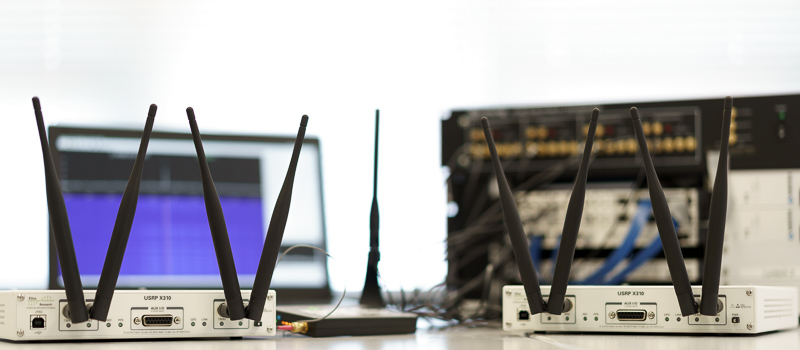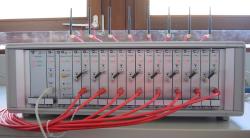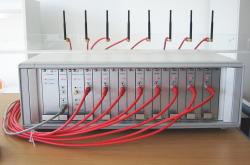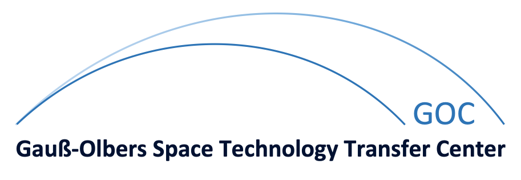Software Defined Radio Demonstrators
Research Process
The ANT aims to transfer results and concepts from basic communications research to practice. For many decades different hardware platforms have either been developed by the department or commercially available reasearch orientied hardware have been aquired (see history). The current demonstrator platform is based on USRPS from Ettus Research and is a central building block in the practical test, verification and refinement of theoretical concepts from current research topics.
The interaction of SDR hardware and software is very flexibel and offers serveral APIs to easily transmit wirelessly. This can be either realied using frameworks like Matlab or GNU radio with code written in Matlab or Pyhton or by optimized C/C++ code.
A typical research project could look like this:
1. Develop theorry and reference implementation for simulation
2. Investigate optimization of algorithms from the reference implementation (e.g. using C)
3. Integrate algorithms in software systems like GNU Radio
4. Evaluatie implementation
5. Demonstrate Over-the-Air performance
Such a process makes transfer of theoretical ideas and concepts towards practice accesabile. Based on this, further improvements of concepts and algorithms considering practical settings and hardware can be idenified and developed. A final step would then be to take the most promision candidate algorithms and implement these on the onboard FPGAs, e.g. using RFNoC in GNU Radio.
History
Lyrtech
The available Lyrtech hardware plattforms (Quad MIMO and PicoSDR) enable implementation of Real Time Processing algorithms for communication technology. For this, the environment consists of multiple programable elements (four Xilinx Virtex-4 FPGAs and four TI DSPs C6416). Under using the simulation tool Simulink from Mathworks Inc. algortihm will be designed in a model-based description, after that hardware files will be generated.
Self-delevoped: The MASI system concept
MASI is our Multiple Antenna System for ISM-Band Transmission.
One motivation to built a MIMO hardware demonstrator is that the assumptions made about real channels may be incorrect, and the behavior of MIMO systems should be investigated under realistic conditions. Therefore it is sufficient to transmit and receive over a real channel and process the received data offline at the workstation environment. This basic idea roots in our single antenna system.
Details
| Duration: | since 06/2010 |
| Funding: | ANT |
| Precursor: | MASI - Multiple Antenna System for ISM-Band Transmission |
Publications
-
An optimized GFDM software implementation for future Cloud-RAN and field tests
BibTEX

J. Demel, C. Bockelmann, A. Dekorsy, Andrej Rode, Sebastian Koslowski, Friedrich K. Jondral
GNU Radio Conference 2017, San Diego, USA, 11. - 15. September 2017 -
Evaluation of a Software Defined GFDM Implementation for Industry 4.0 Applications
BibTEX

J. Demel, C. Bockelmann, A. Dekorsy
IEEE International Conference on Industrial Technology (ICIT 2017), Toronto, Canada, 22. - 25. March 2017 -
Analysis and Implementation for Physical-Layer Network Coding with Carrier Frequency Offset
BibTEX

M. Wu, F. Ludwig, M. Woltering, D. Wübben, A. Dekorsy, S. Paul
International ITG Workshop on Smart Antennas (WSA2014), Erlangen, Germany, 12. - 13. March 2014










